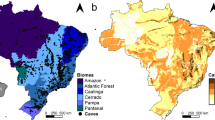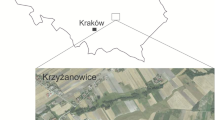Summary
A marked variation exists in the numbers and distribution of East African red legged millipedeMetiche tanganyciense Kraus on the surface and in the lower layer (15 cm) of the soils. Stadia 5 cm and lesser in length are found in the lower layer and those 5 cm and above on the surface soil. Adults are common in varying numbers in both the habitats.
It is suggested that after becoming surface active during March–August, and mating, adults migrate to lower layer during September to oviposit. Eggs and early developmental stages are passed here, and when they are 5 cm in length, the stadia move to the surfface soil to complete their development. In keeping with this behaviour, spatial distribution of the adults may change from non-aggregation on surface soil to aggregation in the lower layer. The simulataneous presence of adults and developing stadia in the two habitats suggests and overlapping of generations.
Similar content being viewed by others
References
Banerjee, B. (1967a) Seasonal changes in the distribution of the millipedeCylindroiulus punctatus (Leach) in decaying logs and soils.J. Anim. Ecol. 36: 171–177.
Banerjee, B. (1967b) Diurnal and seasonal variations in the activity of the millipedesCylindroiulus punctatus (Leach),Tachypodoiulus niger (Leach) andPolydesmus angustus Latzel Oikos 18: 141–144.
Banerjee, B. (1970) A mathematical model on sampling diplopods using pitfall traps.Oecologia 4: 102–105.
Banerjee, B. (1973) The breeding biology ofPolydesmus angustus Latzel Norsk. ent. Tidsskr. 20: 291–294.
Banerjee, B. (1974) Population dynamics ofTrigoniulus lumbricinus (Gerst) (Diplopoda: Trigoniulidae).Res. Popul. Ecol. 16: 132–137.
Banerjee, B. (1976) Variance to mean ratio and the spatial distribution of animals.Experientia 32: 993–994.
Barlow, C. A. (1957) A factorial analysis of distribution in three species of diplopods.Tijdschr. Ent. 100: 349–426.
Blower, J. G. (1969) Age-structure of millipede populations in relation to activity and dispersion.Syst. Ass. Publs. 8: 209–216.
Blower, J. G. (1970) The millipedes of a Cheshire wood.J. Zool. Lond. 160: 455–496.
Causey, N. B. andD. L. Tieman (1969) A revision of the bioluminescent millipedes of the genusMotyxia (Xystodesmidae, Polydesmida).Proc. Am. Phil. Soc. 113: 14–33.
Dowdy, W. W. (1944) The influence of temperature on vertical migration of invertebrates inhabiting different soil types.Ecology. 25: 449–460.
Fairhwist, C. P. andJ. G. Blower (1968) Notes on the life-history and ecology ofTachypodoiulus niger (Diplopoda: Iulidae) in Britain.J. Zool. Lond. 156: 257–271.
Halkka, K. (1958) Life history ofSchizophyllum sabulosum (L.) (Diplopoda, Iulidae).Ann. Zool. Soc. “Vanamo”.19: 1–72.
Hoffman, R. L. (1967) Polydesmoid Diplopoda from Nigeria.Revue Zool. Bot. afr.,76: 201–234.
Lewis, J. G. E. (1971a) The life history and ecology of the millipedeTymbodesmus falcatus (Polydesmida: Gomphodesmidae) in northern Nigeria with notes onSphenodesmus sheribongensis.J. Zool. Lond. 164: 551–563.
Lewis, J. G. E. (1971b) The life history and ecology of three paradoxosomatid millipedes (Diplopoda: Polydesmida) in northern Nigeria.J. Zool. Lond. 165: 431–452.
Lind, E. M. andM. E. S. Morrison (1974)East African vegitation. Longmans, 257 pp.
Shali, F. (1961) La succession des differentes formes males an cours de la periodomorphose chez le DiplopodeTachypodoiulus albipes C. L. Koch.C. r. hebd. Seane. Acad. Sci. Paris.253: 3094–3095.
Schiøtz, V. (1966) Notes on West African diplopods II. The family Gomphodesmidae (Polydesmida), with a description of a new sub-family.Vedensk. Meddr dansk naturh. Foren. 129: 105–122.
Schmidt, H. (1952) Nahungswahl und Nahrungsverarbeitung bei diplopoden (Tausendfusslern).Mitt. naturwiss. Vereins. Steiermark. 81/82: 42–66.
Sutton, S. L. (1968) The population dynamics ofTrichoniscus pussillus andPhiloscia muscorum (Crustacea: Oniscoidae) in limestone grassland.J. Anim. Ecol. 37: 425–444.
Taylor, L. R. (1961) Aggregation, variance and the mean.Nature 189: 732–735.
Author information
Authors and Affiliations
Additional information
This investigation was done while I was in the Department of Entomology, University of Nairobi.
Rights and permissions
About this article
Cite this article
Banerjee, B. The population characteristics of the East African red legged diplopodMetiche tanganyciense Kraus (Diplopoda: Spirobolidae). Res Popul Ecol 21, 308–316 (1980). https://doi.org/10.1007/BF02513628
Issue Date:
DOI: https://doi.org/10.1007/BF02513628




